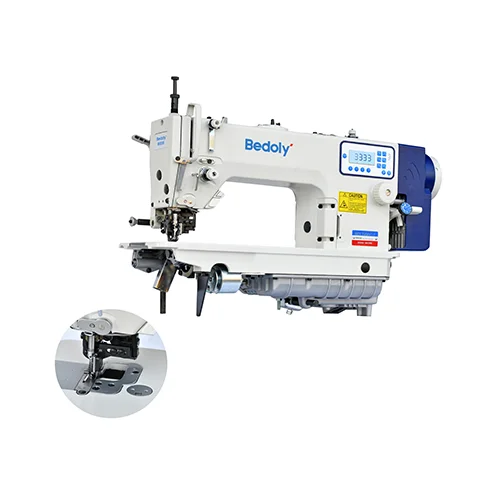As a leading manufacturer specializing in sewing machine research, development, and production, Sanhexin Automation Co., Ltd. understands the importance of proper setup for optimal performance. Our computerized side cutter sewing machines are at the forefront of modern garment manufacturing, combining advanced technology with high efficiency. This guide provides a step-by-step process for correctly installing your side cutter sewing machine, ensuring it operates efficiently and effectively, so you can make the most of your new machine.
What is a Side Cutter Sewing Machine?
A side cutter sewing machine integrates cutting and sewing functions into one streamlined process. This technology allows for precise cutting of fabric edges while simultaneously stitching them, significantly improving efficiency in garment production. Whether you have a computerized model or a side cutter attachment for a standard machine, proper installation is crucial for achieving the best results.
Preparing for Installation
Before you begin, ensure you have the following:
Side cutter sewing machine or side cutter attachment: Make sure all components are present and undamaged.
Screwdrivers: Appropriate sizes for removing and attaching screws.
User manual: Refer to your specific model's instructions for any unique requirements.
Fabric scraps: For testing the machine after installation.
Cleaning supplies: To clean the machine before use.

Step-by-Step Installation Guide
The installation process can vary slightly depending on whether you are installing a complete computerized side cutter sewing machine or attaching a side cutter foot to a standard sewing machine. Follow the steps relevant to your situation.
Installing a Computerized Side Cutter Sewing Machine
Unpacking and Inspection:
Carefully unpack the sewing machine and all its components. Inspect for any shipping damage. Verify that all listed parts are included, such as the power cord, foot pedal, and accessories.
Setting Up the Machine:
Place the sewing machine on a stable, level surface. Ensure there is enough space around the machine for comfortable operation.
Connecting the Power Cord and Foot Pedal:
Plug the power cord into the machine and then into a grounded electrical outlet. Connect the foot pedal to the designated port on the machine.
Installing the Needle:
Loosen the needle clamp screw and insert the needle with the flat side facing the back. Push the needle up as far as it will go and tighten the screw securely.
Threading the Machine:
Follow the threading diagram provided in your user manual. Ensure the thread passes through all the necessary guides, tension discs, and the take-up lever. Wind the bobbin and insert it into the bobbin case.
Adjusting the Settings:
Turn on the machine and navigate the computerized control system. Adjust the settings according to the fabric type and desired stitch pattern. This may include setting the stitch length, width, and cutting parameters.
Testing the Machine:
Use fabric scraps to test the machine's sewing and cutting functions. Make any necessary adjustments to the tension, stitch settings, or cutting blade position to achieve optimal results.
Installing a Side Cutter Attachment on a Standard Sewing Machine
Removing the Existing Presser Foot:
Turn off the sewing machine. Raise the presser foot lever and unscrew the existing presser foot from the presser bar. Retain the screw, as you will need it to attach the side cutter.
Positioning the Side Cutter Attachment:
Set the side cutter in position on the presser bar. Position the forked arm around the needle clamp. Some models have a prong that should cradle the needle screw, allowing the cutter to move with the needle. It might be easiest to approach the machine from behind to line everything up.
Securing the Attachment:
Tighten the screw to secure the attachment in place. Ensure the side cutter is firmly attached but does not restrict the movement of the needle or other components.
Checking Needle Clearance:
Select an over-edge stitch. Turn the hand wheel toward you slowly, making sure the needle goes over the stitch finger. If the needle hits the metal stitch finger, adjust the stitch width or needle position. Ensure the foot is correctly seated on the presser bar. If the needle hits the sides of the attachment, double-check that the foot is correctly seated.
Threading the Machine with the Attachment:
Ensure the thread is correctly routed through the machine and the side cutter attachment. Some attachments require you to pull the thread into the gap in the center of the side cutter, then out behind it.
Preparing the Fabric:
Cut a notch at the top edge of the fabric135. Place the fabric over the first metal platform and then under the second metal platform. Ensure the blade cuts prior to the needle stitching, so have the fabric under the needle before starting to sew.
Testing the Attachment:
Sew slowly, guiding the fabric. If the blade is not cutting, ensure the fabric is correctly placed over the first platform. Check the placement of the fabric in the attachment and continue to sew.
Tips for Successful Installation
Consult the User Manual: Always refer to the user manual for specific instructions and safety guidelines.
Ensure Proper Alignment: Accurate alignment of the cutting blade and needle is crucial for clean cuts and consistent stitching.
Test on Scrap Fabric: Before working on your project, test the machine or attachment on scrap fabric to fine-tune the settings.
Adjust Stitch Settings: Experiment with different stitch settings to achieve the desired finish. Overcast or zigzag stitches are commonly used with side cutters.
Clean Regularly: Keep the machine clean and free of lint to ensure smooth operation.
Troubleshooting Common Issues
Fabric Not Cutting:
Ensure the fabric is properly positioned on the platforms.
Check that the blade is sharp and correctly aligned.
Adjust the cutting depth if possible.
Needle Breakage:
Verify that the needle is correctly installed and not bent.
Ensure the needle has enough clearance and does not hit any part of the attachment.
Use the correct needle type for the fabric.
Uneven Stitches:
Adjust the thread tension.
Check the needle and bobbin threading.
Ensure the fabric is feeding smoothly.
Benefits of Proper Installation
Optimal Performance: Correct installation ensures the machine operates at its best, providing clean cuts and consistent stitches.
Extended Lifespan: Proper setup and maintenance can prolong the life of your sewing machine.
Reduced Downtime: Troubleshooting is minimized when the machine is correctly installed from the start.
Professional Results: Achieve high-quality, professional-looking finishes on your sewing projects.
Why Choose Sanhexin Automation Co., Ltd.?
Sanhexin Automation Co., Ltd. is dedicated to providing innovative and high-quality sewing solutions. Our computerized side cutter sewing machines are designed for efficiency, precision, and ease of use. By following this installation guide, you can ensure your machine operates at its full potential, delivering exceptional results for all your sewing projects.
Conclusion
Installing your side cutter sewing machine or attachment correctly is essential for achieving professional-quality results. Whether you have a computerized model from Sanhexin Automation Co., Ltd. or a side cutter attachment for a standard machine, following these step-by-step instructions will help you maximize its performance and longevity. With proper installation and regular maintenance, you can enjoy efficient, precise, and high-quality sewing for years to come.
Understanding Side Cutter Sewing Machines: Applications and Benefits
www.bedoly.net
Ningbo Sanhexin Automation Co., Ltd

